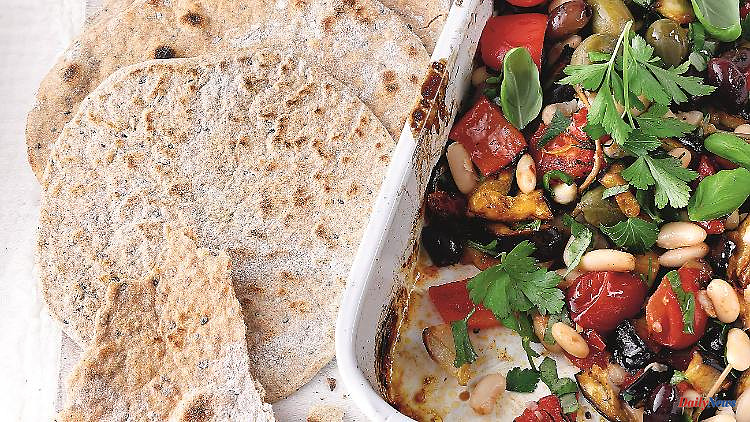Lose weight, strengthen the immune system, improve digestion - too exhausting and not fun? That's not true, say two experts and give us the instructions for use with the vegan wholefood interval fasting.
I tried it: Intermittent fasting works - 10 kilograms less on the scales. And it was even fun, which I never would have believed. Admittedly, not immediately, the start took some effort, but after 14 days I was "in". I had combined my 16:8 fast with a carb cut, especially wheat products and sugar. I felt fitter and healthier, younger and less wrinkled, was in a good mood - I washed myself up on my wave of success, bought clothes one or two sizes smaller ... and then Corona came: 4 kilograms more through frustration eating and couch- squatting What is meant here is not the Spanish beer, but the nasty Sars-CoV-2 virus, you know... You can blame everything possible on this spawn of hell, including your own weakness and failure. My inner bastard is still hoarse today from all the cheering. And I'm pissed off. On me. I want that super body feeling back!
As if they had suspected my self-inflicted vale of tears: Two competent nutrition experts give me and other fellow sufferers new hope with a new book - "Healthy Intermittent Fasting", this time paired with a vegan diet. The miracle weapon of Dr. medical Petra Bracht and Nicole Just was published by Gräfe und Unzer Verlag and not only has very well-founded and helpful advice and tips on 224 pages, but also almost 80 recipes suitable for everyday use. With this combination of a concise and easily understandable introduction to theory with recipes that strengthen the immune system, help to lose weight and activate the metabolism, we actually have a silver bullet in our hands. Healing through intermittent fasting - that is the message of the two bestselling authors, who are publishing a book together for the first time.
Anyone who already practices intermittent fasting or wants to start it again (me!!!), gets here from the nutrition and pain expert and long-time doctor Dr. Brought and the vegan recipe author Just healthy recipes in hand, which counteract many chronic complaints and diseases and also have a prophylactic effect. The guiding principle here is careful use of calories, not too much fat, and a high proportion of fresh food. And the food should also taste good, the authors attach great importance to that. Descriptive food photos that make you want to follow along complete the wealth of plausible information about vegan nutrition, weight loss and pain relief through intermittent fasting.
We eat ourselves sick, says Petra Bracht. In western industrialized countries, the times when phases of sufficient supply alternated with phases when food was scarce are long gone. We no longer know forced fasting during periods of hunger. What's more, we have a drastic oversupply of food. Usually also in my fridge – I just have to grab it. My genes, so the two experts tell me, are still programmed to change between eating and hunger, due to Stone Age conditions. However, because we no longer suffer from hunger, the health-preserving measures that come into play when we are hungry simply fall away. Bracht: "Today we no longer die from hunger, but from eating too much." I like to eat - but do I want to die from it? nope!
Through intermittent fasting, we give our bodies the opportunity to regenerate, repair, and recycle on a daily basis. This self-healing is called autophagy. In this process, old microwaste, damaged cell components and used protein molecules are broken down, broken down and reassembled into new components. The advantage: the muscles do not suffer when we move, even during fasting.
Petra Bracht has been practicing intermittent fasting coupled with a vegan diet for 30 years, she says in an interview. She herself felt that this form of nutrition was good for her, how her body reacted to it. "But when I used this method on my patients, it was crystal clear to me. There is a treasure hidden here that will hopefully one day be recognized by university medicine. And that's exactly how it was. In 2016, the Japanese cell biologist Yoshinori Ohsumi received the Nobel Prize for Medicine Autophagy. For me the healing miracle par excellence, which does not stop at any illness and can actually bring about recovery processes that are unimaginable. Especially with the diseases of civilization, intermittent fasting and plant-based food is the therapy of choice for me. Because as you may have guessed, most are diseases of affluence , as the name suggests, for the most part homemade."
dr In the book, Bracht explains how after about 12 hours of fasting, the metabolism begins to convert fatty acids into energy, into ketone bodies - primarily from unloved and unhealthy belly fat. A waist circumference of up to 80 cm is harmless for women and up to 94 cm for men. I'm going to go and measure on the sly...
The ketones can do a lot. They ensure the energy supply of the heart, brain and other organ systems; they activate nerve cells and create new brain cells; they have a calming effect on all chronic inflammations that are typical of autoimmune diseases and lifestyle diseases: pain subsides, blood pressure levels drop, blood sugar levels normalize and allergy symptoms decrease. Ketones also lower negative LDL cholesterol levels and can even slow down the growth of cancer cells because they mostly feed on sugar and not fatty acids.
But anyone who thinks that they can gain their energy from ketones over the long term is wrong. And this mistake is even dangerous, because genetically ketones are not intended as a permanent supplier, but they are our emergency energy donors. The long-term renunciation of carbohydrates (e.g. in the paleo diet/paleo diet) ultimately leads to hyperacidity. Our cells and above all our brain need glucose - without it, the good intention turns into the opposite: There are more and more developments that are harmful to health. That is why intermittent fasting is the optimal way for our health in the long term: ketones are formed again and again during the fasting breaks, and the required carbohydrates are taken in with meals.
The book "Gesundmacher Intermittent Fasting" explains in detail how to start, what is important and should definitely be considered, what mistakes you can make and how to avoid them. It is important to know the processes involved in intermittent fasting and to understand how it works. And then it's on to the recipes!
There are basics that can be stored longer and used for different dishes, as well as for breakfast, salads, soups and main courses. In between extra chapters on important building blocks for a vegan diet: oats, wild herbs, turmeric, millet, kale. All extras impart background knowledge and give preparation tips. An extra deals with fermented foods - dearly loved by our intestinal bacteria. The lactic acid bacteria produced during fermentation ensure a healthy intestinal flora and promote digestion - the basic requirement for a well-functioning metabolism. dr Bracht recommends eating fermented foods every day. Two four-week plans, one for 1,200 to 1,500 kcal, the other for 1,700 to 1,900 kcal, make it easier to start a new healthy life.
Preparation:
Closing time: 10 Min. Pro Portion ca. 45 kcal, 0 g E, 0 g F, 10 g KH, O g BST
1. Pour 200 ml of boiling water over the dates, set aside for 5 minutes to steep and then puree into a thick cream.
2. Pour the cream into a clean screw-top jar and store in the fridge. It stays there for 2 weeks. Alternatively, the paste can also be frozen in portions (e.g. in ice cube molds or small glasses), it will then last for several months.
Tip: 1 tablespoon of date paste (approx. 25 g) replaces the same amount of rice syrup or sugar.
Preparation:
Display time: 30 Min.Pro Portion approx. 420 kcal, 10 g E, 9 g F, 71 g KH, 7 g BST
1. Wash the sweet potatoes, peel and cut into cubes of approx. 4 cm. Just cover the cubes with water and cook covered for 7-10 minutes until soft. Then drain the sweet potatoes through a sieve, let them cool down and puree them finely.
2. For the compote, bring the cherries to the boil with the cherry juice, vanilla and syrup in a saucepan and simmer uncovered over a low heat for 15 minutes. Then remove from the stove, stir the starch with 2 tablespoons of water until smooth and stir into the cherries. Bring to the boil again while stirring and simmer over low heat for 1 minute, stirring frequently. Put aside.
3. Mix the wholemeal spelled flour, cocoa, baking soda and a pinch of salt in a bowl. In another bowl, mix plant drink, vinegar, syrup and sweet potato puree. Add the mixture to the flour, add sparkling water and work into a smooth dough with a whisk. Don't stir for too long!
4. Heat 1 teaspoon of rapeseed oil in a non-stick pan, reduce the temperature to medium and add 1 tablespoon of batter to the pan for each pancake and spread out into circles approx. 10 cm in diameter. Fry the pancakes for approx. 1 min. on each side until golden brown. Make a total of 8 pancakes.
Preparation:
Closing time: 15 Min. Pro Portion ca. 110 kcal, 7 g E, 1 g F, 13 g KH, 8 g BST
1. Peel the garlic and ginger and dice very finely. Remove the core from the chilli and then cut the chilli into very thin slices. Cover and bring the garlic, ginger, chili, vegetable stock powder, soy sauce and 11 water to the boil and then simmer over a medium heat for 10 minutes.
2. Meanwhile, peel, halve and finely slice the onion. Wash and drain the remaining vegetables. Remove the core and the white partitions from the peppers and cut the flesh into very thin strips. Using a spiralizer, process the courgettes into noodles about 0.4 cm thick. Alternatively, use a vegetable peeler to cut off thin strips down to the core (discard the core). Cut the cabbage into very thin strips.
3. Wash and drain herbs and sprouts. When the broth has finished cooking, put the vegetables in the pot, cover and bring to the boil again and then immediately remove the pot from the stove. Divide the soup between 2 plates or bowls. Chop the herbs and sprinkle over the soup along with the sprouts. Finally, sprinkle on the lime zest.
Preparation:
Closing time: 25 Min. Pro Portion ca. 645 kcal, 20 g E, 23 g F, 85 g KH, 12 g BST
1. Peel and finely dice the onion and garlic. Peel the asparagus and cut slightly diagonally into pieces approx. 5 cm long. Wash the herbs and shake dry. Set the basil and chives aside. Pluck the rosemary needles from the stalks and chop finely.
2. In a saucepan, combine the onions, garlic, asparagus, rosemary and pasta with the olive oil, broth, salt, syrup, 300ml water and heavy cream.
Bring to the boil and simmer covered over medium heat for 10-12 minutes. Stir every now and then. The pasta and asparagus should be al dente at the end.
3. Meanwhile, roast the sunflower seeds and sesame seeds in a pan without fat. Mix the seeds, sesame, 2 pinches of salt and the pepper berries with the lemon zest and set aside.
4. Cut the chives into fine rolls, pluck the basil roughly. When the cooking time is up, divide the pasta onto 2 plates and sprinkle with the herbs and the core mixture.
Heidi Driesner wishes you every success on the way to a new body feeling.
(This article was first published on Thursday, May 26, 2022.)












